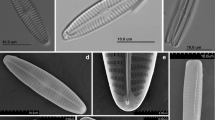Abstract
Bioassays of different complexity were compared with respect to their capability to predict the environmental impact of the herbicide atrazine in aquatic systems. Acute toxicity tests with Daphnia did not yield meaningful results. Sublethal tests with Daphnia (feeding inhibition, reduction of growth and reproduction) were more sensitive, but effective concentrations of atrazine were still rather high (2 mg/L). A relatively complicated ‘artificial food chain’ system that incorporated direct and indirect effects on Daphnia yielded significant reduction of daphnid population growth at 0.1 mg/L. Enclosure experiments with natural communities were by far the most sensitive tools. Community responses could be measured at concentrations as low as 1 µg/L and 0.1 µg atrazine/L. At the lowest concentration, however, communities recovered after three weeks. We conclude that in complex systems indirect effects can be more important than direct effects, so that, contrary to the conditions in simple tests, non-target organisms may be the better indicators of herbicide stress to natural communities.
Similar content being viewed by others
References
Brockway, D. L., P. D. Smith & F. E. Stanci1, 1984. Fate and effect of atrazine in small aquatic microcosms. Bull. Envir. Contain. Toxicol. 32: 345–353.
Butler, G. L., 1977. Algae and pesticides. Residue Rev. 66: 19–62.
DeNoyelles, F., Jr., W. D. Kettle & D. E. Sinn, 1982. The responses of plankton communities to atrazine, the most heavily used pesticide in the United States. Ecology 63: 1285–1293.
Dewey, S. L., 1986. Effects of the herbicide atrazine on aquatic insect community structure and emergence. Ecology 67: 148–162.
Fleckner, W., 1989. Ökotoxikologische Untersuchungen mit Herbiziden in eingeschlossenen Wasserkörpern. Direkte und indirekte Wirkungen von 2,4-D und Atrazin auf Planktonbiocoenosen und physikalisch-chemische Parameter. Diss. Univ. Kiel, 240 pp.
Frank, R., B. D. Ripley, H. E. Braun, B. S. Clegg, R. Johnston & T. J. O'Neill, 1987. Survey of farm wells for pesticide residues, Southern Ontario, Canada, 1981–1982, 1984. Arch. Envir. Contam. Toxicol. 16: 1–8.
Krambeck, H. J., W. Lampert & H. Brede, 1981. Messung geringer Mengen von partikulärem Kohlenstoff in naturlichen Gewässern. GIT Fachz. Labor. 25: 1009–1012.
Lampert, W., 1976. A directly coupled, artificial two-step food chain for long-term experiments with filter-feeders at constant food concentrations. Mar. Biol. 37: 349–355.
Lampert, W. (ed.), 1985. Food limitation and the structure of zooplankton communities. Arch. Hydrobiol. Beih. Ergebn. Limnol. 21: 1–497.
Lampert, W. & U. Schober, 1980. The importance of ‘threshold’ food concentrations. In W. C. Kerfoot (ed.), Evolution and ecology of zooplankton communities, University Press of New England, Hanover, New Hampshire, pp. 264–267.
Larsen, D. P., F. DeNoyelles, Jr., F. Stay & T. Shiroyama, 1986. Comparisons of single-species, microcosm and experimental pond responses to atrazine exposure. Envir. Toxicol. Chem. 5: 179–190.
Oehmichen, U. & K. Haberer, 1986. Stickstoffherbizide im Rhein. Vom Wasser 66: 225–241.
Plumley, F. G. & D. E. Davis, 1980. The effect of a photosynthesis inhibitor atrazine, on salt marsh edaphic algae, in culture, microecosystems, and in the field. Estuaries 3: 271–277.
Pott, E., 1980. Die Hemmung der Futteraufnahme von Daphnia pulex — eine neue limnotoxikologische Meßgröße. Z. Wasser Abwasser Forsch. 13: 52–54.
Pott, E., 1982. Experimentelle Untersuchungen zur Wirkung von Herbiziden auf die Futteraufnahme von Daphnia pulicaria Forbes. Arch. Hydrobiol. Suppl. 59: 330–358.
Schober, U. & W. Lampert, 1977. Effects of sublethal concentrations of the herbicide Atrazin on growth and reproduction of Daphnia pulex. Bull. Envir. Contam. Toxicol. 17: 269–277.
Shapiro, J., 1980. The importance of trophic-level interactions to the abundance and species composition of algae in lakes. Develop. Hydrobiol. 2: 105–116.
Stay, F. S., D. P. Larsen, A. Katko & C. M. Rohm, 1985. Effects of atrazine on community level responses in Taub microcosms. In T. P. Boyle (ed.), Validation and predictability of laboratory methods for assessing the fate and effects of contaminants in aquatic ecosystems. ASTM STP 865, American Society for Testing and Materials, Philadelphia, pp. 75–90.
Störkel, K.-U., 1983. Toxikologische Untersuchungen an einer zweistufigen Labornahrungskette. Diss. Univ. Frankfurt/Main, 105 pp.
Störkel, K.-U. & W. Lampert, 1981. Sublethale Schadstoffwirkungen auf ein Modell einer limnischen Nahrungskette. Verh. Ges. Ökol. 9: 255–260.
Taub, F. B. & M. E. Crow, 1981. Synthesizing aquatic microcosms. In J. P. Giesy (ed.), Microcosms in ecological research, CONF 781101, Technical Information Service, Springfield, VA, pp. 69–104.
Torres, A. M. R. & L. M. O'Flaherty, 1976. Influence of pesticides on Chlorella, Chlorococcum, Stigeoclonium (Chlorophyceae), Tribonema, Vaucheria (Xanthophyceae) and Oscillatoria (Cyanophyceae). Phycologia 15: 25–36.
Wilson, M. P., E. P. Savage, D. D. Adrian, M. J. Aaronson, T. J. Keefe, D. H. Hamar & J. T. Tessari, 1987. Groundwater transport of the herbicide atrazine, Weld County, Colorado. Bull. Envir. Contam. Toxicol. 39: 807–814.
Author information
Authors and Affiliations
Rights and permissions
About this article
Cite this article
Lampert, W., Fleckner, W., Pott, E. et al. Herbicide effects on planktonic systems of different complexity. Hydrobiologia 188, 415–424 (1989). https://doi.org/10.1007/BF00027809
Issue Date:
DOI: https://doi.org/10.1007/BF00027809




